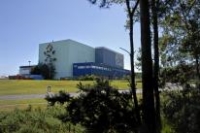Research Sites Restoration Ltd (RSRL) is looking for bidders for a £40-60 million ($66-100 million) project to design, test and build the specialist equipment to remove the core from the UK's prototype steam generating heavy water reactor (SGHWR).
 |
| The SGHWR (Image: RSRL) |
Removal of the highly active 250-tonne core is a critical part of the final decommissioning, leading to the demolition of the primary containment and all remaining buildings and facilities by a planned deadline of 2021.
The successful bidder will be required to deliver a fully-functioning system to decommission the core by jacking core components from below into a shielded cell where they will be segmented. These segments will then be transferred into an auxiliary area for further size reduction and packaging into waste baskets, followed by transfer into a dedicated intermediate level waste (ILW) export facility. The contractor will also be required to design and build full-scale mock-ups of the reactor core and core segmentation cell plus other equipment for testing and development of the techniques and tools to be used.
RSRL is holding a briefing event for suppliers later this month and anticipates issuing invitations to tender to selected candidates by 10 October, identifying a preferred bidder and awarding a contract in July 2015.
Prototype reactor
The SGHWR was built as a power-producing prototype to demonstrate the viability of the heavy water-cooled reactor system. The 100 MWe unit began operation in 1968 and provided electricity to the grid until its closure in 1990. Even after the UK government's decision in the mid-1970s not to pursue an SGHWR program, the unit continued to fulfil its experimental role supporting studies on water-cooled reactor technology.
Decommissioning of the SGHWR, at the former Winfrith nuclear research site in the county of Dorset, has been under way for over two decades and is now in its final stages. The first stage of the project, which ran between 1991 and 2005, saw the removal of the unit's 279 fuel elements which were then transferred to the Sellafield site. The heavy water moderator was also removed. There followed a second stage of work to decommission and remove major items of plant and equipment in the unit's secondary containment building.
Winfrith was home to nine unique reactors and associated facilities before decommissioning work began in the 1990s. Today, only two - SGHWR and the Dragon prototype high-temperature gas-cooled reactor - remain. Most of the Dragon plant has now been removed. Its reactor pressure vessel remains, but its removal will also involve the design and construction of a new shielded, remotely-operated facility over the reactor's core. Large areas of the Winfrith site have already been delicensed and freed for future development.
Researched and written
by World Nuclear News




_18570.jpg)
_16159.jpg)
_49205.jpg)
_18938.jpg)





